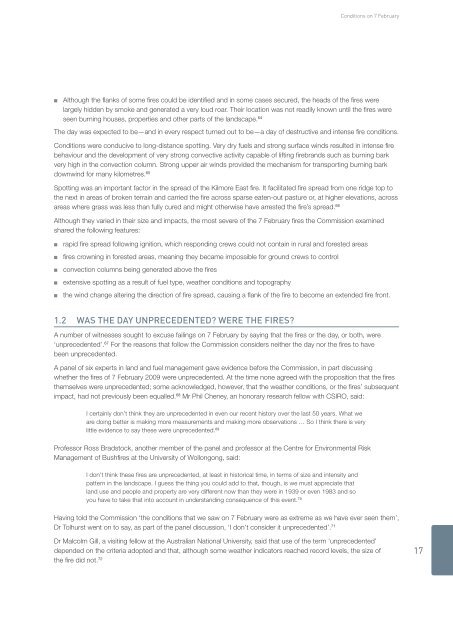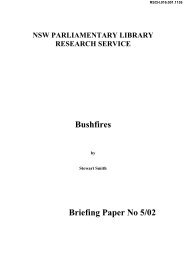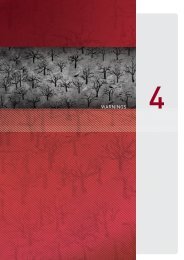1 CONDITIONS ON 7 FEBRUARY - 2009 Victorian Bushfires Royal ...
1 CONDITIONS ON 7 FEBRUARY - 2009 Victorian Bushfires Royal ...
1 CONDITIONS ON 7 FEBRUARY - 2009 Victorian Bushfires Royal ...
Create successful ePaper yourself
Turn your PDF publications into a flip-book with our unique Google optimized e-Paper software.
Conditions on 7 February<br />
■■<br />
Although the flanks of some fires could be identified and in some cases secured, the heads of the fires were<br />
largely hidden by smoke and generated a very loud roar. Their location was not readily known until the fires were<br />
seen burning houses, properties and other parts of the landscape. 64<br />
The day was expected to be—and in every respect turned out to be—a day of destructive and intense fire conditions.<br />
Conditions were conducive to long-distance spotting. Very dry fuels and strong surface winds resulted in intense fire<br />
behaviour and the development of very strong convective activity capable of lifting firebrands such as burning bark<br />
very high in the convection column. Strong upper air winds provided the mechanism for transporting burning bark<br />
downwind for many kilometres. 65<br />
Spotting was an important factor in the spread of the Kilmore East fire. It facilitated fire spread from one ridge top to<br />
the next in areas of broken terrain and carried the fire across sparse eaten-out pasture or, at higher elevations, across<br />
areas where grass was less than fully cured and might otherwise have arrested the fire’s spread. 66<br />
Although they varied in their size and impacts, the most severe of the 7 February fires the Commission examined<br />
shared the following features:<br />
■■<br />
■■<br />
■■<br />
■■<br />
■■<br />
rapid fire spread following ignition, which responding crews could not contain in rural and forested areas<br />
fires crowning in forested areas, meaning they became impossible for ground crews to control<br />
convection columns being generated above the fires<br />
extensive spotting as a result of fuel type, weather conditions and topography<br />
the wind change altering the direction of fire spread, causing a flank of the fire to become an extended fire front.<br />
1.2 Was the day unprecedented? Were the fires?<br />
A number of witnesses sought to excuse failings on 7 February by saying that the fires or the day, or both, were<br />
‘unprecedented’. 67 For the reasons that follow the Commission considers neither the day nor the fires to have<br />
been unprecedented.<br />
A panel of six experts in land and fuel management gave evidence before the Commission, in part discussing<br />
whether the fires of 7 February <strong>2009</strong> were unprecedented. At the time none agreed with the proposition that the fires<br />
themselves were unprecedented; some acknowledged, however, that the weather conditions, or the fires’ subsequent<br />
impact, had not previously been equalled. 68 Mr Phil Cheney, an honorary research fellow with CSIRO, said:<br />
I certainly don’t think they are unprecedented in even our recent history over the last 50 years. What we<br />
are doing better is making more measurements and making more observations … So I think there is very<br />
little evidence to say these were unprecedented. 69<br />
Professor Ross Bradstock, another member of the panel and professor at the Centre for Environmental Risk<br />
Management of <strong>Bushfires</strong> at the University of Wollongong, said:<br />
I don’t think these fires are unprecedented, at least in historical time, in terms of size and intensity and<br />
pattern in the landscape. I guess the thing you could add to that, though, is we must appreciate that<br />
land use and people and property are very different now than they were in 1939 or even 1983 and so<br />
you have to take that into account in understanding consequence of this event. 70<br />
Having told the Commission ‘the conditions that we saw on 7 February were as extreme as we have ever seen them’,<br />
Dr Tolhurst went on to say, as part of the panel discussion, ‘I don’t consider it unprecedented’. 71<br />
Dr Malcolm Gill, a visiting fellow at the Australian National University, said that use of the term ‘unprecedented’<br />
depended on the criteria adopted and that, although some weather indicators reached record levels, the size of<br />
the fire did not. 72<br />
17
















